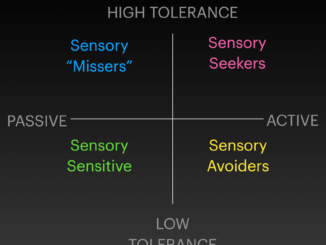I thought it would be helpful to have some definitions of some terms that I might use this month (and also throughout my writing).
***
Autism/Autistic: I will be posting several definitions, one tomorrow and more throughout the month, of autism from a strengths-based reframe. At very least, it is worth thinking about and reconsidering the way our society frames it.
Allistic: The opposite of autistic, someone who does not have autism. (A page I love called “Diary of a Mom” uses the word “nautistic” (pronounced not-tistic), which is her adult Autistic daughter’s word for people who are not autistic.)
Neurotypical: Someone whose brain does not exhibit neurological differences. You might see this abbreviated NT.
Neurodiverse/Neurodiversity: A descriptor for a collective of people with different neurotypes. Some of them might be neurotypical and some of them neurodivergent, or different kinds of neurodivergent. You might see this abbreviated ND. Unless everybody in your group is neurotypical, then any group will be neurodiverse — like, as a collective, the whole of humanity is neurodiverse.
Neurodivergent: An individual person who is not neurotypical. (A person can be divergent, but a single person cannot be “diverse”. So, one person is neurodivergent.) You might also see this abbreviated ND as well.
Stimming: Often miscategorized as being a specifically autistic (or neurodivergent) thing, stimming, short for “self-stimulating behavior”, is any repetitive comforting sensory behavior. (It’s sometimes called “stereotypy”, although that’s overly professional/medical and/or outdated for everyday use.) The “classic” stimming behaviors are hand flapping, spinning, rocking, etc. But there are so many stims in the world that it would be impossible to list them all, and everybody stims. Picking at nails, cuticles, lips, hair; twirling a ring, fidgeting keys, fiddling with a necklace or bracelet or hemline; humming, whistling, singing, talking to oneself; I could go on and on. Stimming is self-regulating, and so it may arise from comfort or from stress. Trying to suppress a stim without finding an acceptable replacement is an inappropriate goal, unlikely to succeed at best, and harmful at worst.
Echolalia: Can be a type of stimming and, again, is not necessarily solely associated with autism. It just means echoing somebody’s words (with something of an element of compulsion about it). I have had at least 2 adult friends who were not autistic who echoed the words of the person speaking to them as a sort of means of auditory processing of what they were saying. In a person with autism, it might look like echoing the last word or phrase of whatever was just said to them, or pulling out a specific word that they seized on in what was being said to them. It is different from, but often part of, gestalt language processing (which is sometimes called “delayed echolalia” or “scripting”), described next.
Scripting: A tool that some autistic people use for communicating and, again, to some extent, something that we all use. (Every time I pick up a phone I say “Hi, this’s Kelsie” in just about the exact same intonation! Have you ever accidentally gotten trapped in a loop with somebody where they said “Hey, how you doing” and you said “Good, how’re you” and they said “Good, how’re you” because they accidentally re-looped their existing script instead of steering into new conversation?) Autistic people might use it more in-depth and more specifically, and having scripts for scenarios they encounter frequently can be helpful for navigating conversations. This is not the same as echolalia. It is not repeating a thing that was just said, but drawing on a familiar thing to say. Especially in kids or in a situation where the autistic person feels comfortable, it might involve repeating scripts from shows, movies, songs, etc. It might not be an easy communication tool for an NT person to understand, but that doesn’t make it any less a communication tool. Again, it might be called “delayed echolalia” or part of “gestalt language processing”.
Gestalt Language Processing: A completely valid path to language learning that involves first learning large multi-word phrases, called “gestalts”, and eventually learning to break them down into individual words at a time or rearrange them to expreess different concepts. This is commonly and some have argued ubiquitously the way in which Autistic children learn language. Sometimes abbreviated GLP. GLP differs from the path to language learning that people are more familiar with, learning one word at a time and then later learning to string those words together, sometimes called “analytical language processing”.
Masking: Hiding autistic traits. Having to suppress them for some reason or another. With almost all autistic kids in the past, and with far too many in the present, the focus of “treatment” of autism hasn’t been so much from the direction of alleviating or finding ways to manage painful symptoms (i.e., of sensory overload), but rather of teaching autistic kids to mask. This is hugely harmful and even traumatizing to people with autism and can lead to poorer mental health outcomes, self-injurious behaviors, self-hatred, etc. Masking should not be confused with “code switching” — i.e., choosing to reveal some part of yourself or disguise some part of yourself because of the appropriateness of a social situation. It is okay to learn and realize that in x scenario, y behavior may not be received well, and that it could wait until later. This social awareness and decision-making metric should ALWAYS be a collaborative effort of learning with an autistic child, or fully and entirely made by an autistic adult, rather than being something enforced upon them externally by a NT person.
Ableism: Discrimination in society by able-bodied people against disabled people. Like with many other prejudices, ableism can be both interpersonal — like for example, one person talking down to another person, or assuming they are unintelligent, because they are nonspeaking — and also structural/systemic — like disabled people losing government assistance if they get married because the system assumes that people with certain disabilities are incapable of marriage.


